Inverse Design of Low-Resistivity Ternary Gold Alloys via Interpretable Machine Learning and Proactive Search Progress
Abstract
:1. Introduction
2. Method
2.1. Dataset
2.2. Model Construction
2.3. Evaluation Metrics
2.4. PSP
2.5. Pattern Recognition Validation
3. Results and Discussions
3.1. Data Preparation
3.2. Feature Selection
3.3. Model Construction and Evaluation
3.4. Model Interpretation
3.5. Model Application
3.5.1. Proactive Search Process
3.5.2. Pattern Recognition
3.5.3. Data Visualization
3.6. Comparation of Related Work
4. Conclusions and Outlooks
- (1)
- Based on 51 TGA samples, the SVR model was established to predict their target electrical resistance, after comparing with its counterpart models, whose LOOCV R and RMSE were 0.73 and 0.281, respectively. The independent test set also yielded an R2 and RMSE of 0.77 and 0.332, indicating the good fitness of the SVR model.
- (2)
- A series of samples was designed through the utilization of our self-developed PSP method, and eight candidates were selected. The results of pattern recognition further demonstrated the feasibility of our sample design method.
- (3)
- The SHAP method was introduced to indicate that lower electrical resistivity occurs when Vrt equals 0, Vr is less than 217, and Macm is greater than 77.5 cm2g−1.
Supplementary Materials
Author Contributions
Funding
Institutional Review Board Statement
Informed Consent Statement
Data Availability Statement
Conflicts of Interest
References
- Bonfil, Y.; Brand, M.; Kirowa-Eisner, E. Characteristics of Subtractive Anodic Stripping Voltammetry of Lead, Cadmium and Thallium at Silver-Gold Alloy Electrodes. Electroanalysis 2003, 15, 1369–1376. [Google Scholar] [CrossRef]
- Haochun, T.; Chun-Yi, C.; Tso-Fu Mark, C.; Takashi, N.; Daisuke, Y.; Toshifumi, K.; Katsuyuki, M.; Katsuyuki, M.; Kazuya, M.; Masato, S. Au–Cu Alloys Prepared by Pulse Electrodeposition toward Applications as Movable Micro-Components in Electronic Devices. J. Electrochem. Soc. 2018, 165, D58. [Google Scholar]
- Liu, H.; Xue, S.; Tao, Y.; Long, W.; Zhong, S. Design and solderability characterization of novel Au–30Ga solder for high-temperature packaging. J. Mater. Sci. Mater. Electron. 2020, 31, 2514–2522. [Google Scholar] [CrossRef]
- Gao, R.; Wen, S.; Li, A.; Zhang, H.; Du, W.; Deng, B. A novel low-resistance damper for use within a ventilation and air conditioning system based on the control of energy dissipation. Build. Environ. 2019, 157, 205–214. [Google Scholar] [CrossRef]
- Ran, G.; Ran, G.; Zhiyu, F.; Angui, L.; Kaikai, L.; Zhigang, Y.; Beihua, C. A novel low-resistance tee of ventilation and air conditioning duct based on energy dissipation control. Appl. Therm. Eng. 2017, 132, 790–800. [Google Scholar]
- Rapaport, D.C. The Art of Molecular Dynamics Simulation; Cambridge University Press: Cambridge, UK, 2004. [Google Scholar]
- Kohn, W.; Sham, L.J. Self-consistent equations including exchange and correlation effects. Phys. Rev. 1965, 140, A1133. [Google Scholar] [CrossRef]
- Hohenberg, P.; Kohn, W. Inhomogeneous electron gas. Phys. Rev. 1964, 136, B864. [Google Scholar] [CrossRef]
- Binder, K.; Heermann, D.W.; Binder, K. Monte Carlo Simulation in Statistical Physics; Springer: Berlin/Heidelberg, Germany, 1992. [Google Scholar]
- Alfè, D.; Pozzo, M.; Desjarlais, M.P. Lattice electrical resistivity of magnetic bcc iron from first-principles calculations. Phys. Rev. B 2012, 85, 024102. [Google Scholar] [CrossRef]
- Yoshino, H.; Iwasaki, Y.; Tanaka, R.; Tsujimoto, Y.; Matsuoka, C. Crystal Structures and Electrical Resistivity of Three Exotic TMTSF Salts with I 3−: Determination of Valence by DFT and MP2 Calculations. Crystals 2020, 10, 1119. [Google Scholar] [CrossRef]
- Zhang, Y.; Luo, K.; Hou, M.; Driscoll, P.; Salke, N.P.; Minár, J.; Prakapenka, V.B.; Greenberg, E.; Hemley, R.J.; Cohen, R.E.; et al. Thermal conductivity of Fe-Si alloys and thermal stratification in Earth’s core. Proc. Natl. Acad. Sci. USA 2022, 119, e2119001119. [Google Scholar] [CrossRef]
- Raghuraman, V.; Wang, Y.; Widom, M. An investigation of high entropy alloy conductivity using first-principles calculations. Appl. Phys. Lett. 2021, 119, 121903. [Google Scholar] [CrossRef]
- Burke, K. Perspective on density functional theory. J. Chem. Phys 2012, 136, 150901. [Google Scholar] [CrossRef] [PubMed]
- Verma, P.; Truhlar, D.G. Status and challenges of density functional theory. Trends. Chem. 2020, 2, 302–318. [Google Scholar] [CrossRef]
- Cohen, A.J.; Mori-Sánchez, P.; Yang, W. Challenges for density functional theory. Chem. Rev. 2012, 112, 289–320. [Google Scholar] [CrossRef]
- Roy, A.; Hussain, A.; Sharma, P.; Balasubramanian, G.; Taufique, M.F.N.; Devanathan, R.; Singh, P.; Johnson, D.D. Rapid discovery of high hardness multi-principal-element alloys using a generative adversarial network model. Acta Mater. 2023, 257, 119177. [Google Scholar] [CrossRef]
- Deffrennes, G.; Terayama, K.; Abe, T.; Ogamino, E.; Tamura, R. A framework to predict binary liquidus by combining machine learning and CALPHAD assessments. Mater. Design 2023, 232, 112111. [Google Scholar] [CrossRef]
- Ma, Y.; Li, M.; Mu, Y.; Wang, G.; Lu, W. Accelerated Design for High-Entropy Alloys Based on Machine Learning and Multiobjective Optimization. J. Chem. Inf. Model. 2023, 63, 6029–6042. [Google Scholar] [CrossRef]
- Feng, X.; Wang, Z.; Jiang, L.; Zhao, F.; Zhang, Z. Simultaneous enhancement in mechanical and corrosion properties of Al-Mg-Si alloys using machine learning. J. Mater. Sci. Technol. 2023, 167, 1–13. [Google Scholar] [CrossRef]
- Wang, X.; Lu, T.; Zhou, W.; Ji, X.; Lu, W.; Yang, J. Accelerated Discovery of Ternary Gold Alloy Materials with Low Resistivity via an Interpretable Machine Learning Strategy. Chem. Asian J. 2022, 17, e202200771. [Google Scholar] [CrossRef]
- Niu, B.; Lu, W.-C.; Yang, S.-S.; Cai, Y.-D.; Li, G.-Z. Support vector machine for SAR/QSAR of phenethyl-amines. Acta Pharmacol. Sin. 2007, 28, 1075–1086. [Google Scholar] [CrossRef]
- Lundberg, S.M.; Lee, S.-I. A unified approach to interpreting model predictions. Adv. Neural Inf. Process. Syst. 2017, 30. [Google Scholar]
- Hsu, W.H. Genetic Algorithms; Department of Computing and Information Sciences, Kansas State University: Manhattan, KS, USA, 2004; Volume 234. [Google Scholar]
- Guyon, I.; Elisseeff, A. An introduction to variable and feature selection. J. Mach. Learn. Res. 2003, 3, 1157–1182. [Google Scholar]
- Quinlan, J.R. Induction of decision trees. Mach. Learn. 1986, 1, 81–106. [Google Scholar] [CrossRef]
- Cover, T.; Hart, P. Nearest neighbor pattern classification. IEEE Trans. Inf. Theory 1967, 13, 21–27. [Google Scholar] [CrossRef]
- Breiman, L. Random Forests. Mach. Learn. 2001, 45, 5–32. [Google Scholar] [CrossRef]
- Chen, T.; Guestrin, C. Xgboost: A scalable tree boosting system. In Proceedings of the 22nd ACM SIGKDD International Conference on Knowledge Discovery and Data Mining, San Francisco, CA, USA, 13–17 August 2016; pp. 785–794. [Google Scholar]
- Lu, T.; Li, H.; Li, M.; Wang, S.; Lu, W. Inverse design of hybrid organic–inorganic perovskites with suitable bandgaps via proactive searching progress. ACS Omega 2022, 7, 21583–21594. [Google Scholar] [CrossRef] [PubMed]
- Rasmussen, C.E.; Williams, C.K. Gaussian Processes for Machine Learning; Springer: Berlin/Heidelberg, Germany, 2006. [Google Scholar]
- Xu, P.; Lu, T.; Ji, X.; Li, M.; Lu, W. Machine Learning Combined with Weighted Voting Regression and Proactive Searching Progress to Discover ABO3-δ Perovskites with High Oxide Ionic Conductivity. J. Phys. Chem. C 2023, 127, 17096–17108. [Google Scholar] [CrossRef]
- Wu, Y.; Shang, Z.; Lu, T.; Zhou, W.; Li, M.; Lu, W. Target-directed discovery for low melting point alloys via inverse design strategy. J. Alloys Compd. 2024, 971, 172664. [Google Scholar] [CrossRef]
- Jolliffe, I.T.; Cadima, J. Principal component analysis: A review and recent developments. Philos. Trans. R. Soc. A 2016, 374, 20150202. [Google Scholar] [CrossRef]
- Wold, S.; Esbensen, K.; Geladi, P. Principal component analysis. Chemometr. Intell. Lab. Syst. 1987, 2, 37–52. [Google Scholar] [CrossRef]
- Chen, C.; Cao, X.; Tian, L. Partial least squares regression performs well in MRI-based individualized estimations. Front. Neurosci. 2019, 13, 1282. [Google Scholar] [CrossRef] [PubMed]
- Belhumeur, P.N.; Hespanha, J.P.; Kriegman, D.J. Eigenfaces vs. Fisherfaces: Recognition using class specific linear projection. IEEE Trans. Pattern Anal. Mach. Intell. 1997, 19, 711–720. [Google Scholar] [CrossRef]
- Wu, M.; Tikhonov, E.; Tudi, A.; Kruglov, I.; Hou, X.; Xie, C.; Pan, S.; Yang, Z. Target-Driven Design of Deep-UV Nonlinear Optical Materials via Interpretable Machine Learning. Adv. Mater 2023, 35, 2300848. [Google Scholar] [CrossRef] [PubMed]
- Bondi, A. van der Waals Volumes and Radii. J. Phys. Chem. 1964, 68, 441–451. [Google Scholar] [CrossRef]
- Rowland, R.S.; Taylor, R. Intermolecular Nonbonded Contact Distances in Organic Crystal Structures: Comparison with Distances Expected from van der Waals Radii. J. Phys. Chem. C 1996, 100, 7384–7391. [Google Scholar] [CrossRef]
- Mantina, M.; Chamberlin, A.C.; Valero, R.; Cramer, C.J.; Truhlar, D.G. Consistent van der Waals radii for the whole main group. J. Phys. Chem. A 2009, 113, 5806–5812. [Google Scholar] [CrossRef]
- Zefirov, Y.V.; Zorkii, P. Van der Waals radii and their application in chemistry. Russ. Chem. Rev 1989, 58, 421. [Google Scholar] [CrossRef]
- Heer, J.; Shneiderman, B. Interactive dynamics for visual analysis: A taxonomy of tools that support the fluent and flexible use of visualizations. Queue 2012, 10, 30–55. [Google Scholar] [CrossRef]
- Heer, J.; Mackinlay, J.; Stolte, C.; Agrawala, M. Graphical Histories for Visualization: Supporting Analysis, Communication, and Evaluation. IEEE T. Vis. Comput. Gr. 2008, 14, 1189–1196. [Google Scholar] [CrossRef]
- Zhang, S.; Lu, T.; Xu, P.; Tao, Q.; Li, M.; Lu, W. Predicting the Formability of Hybrid Organic–Inorganic Perovskites via an Interpretable Machine Learning Strategy. J. Phys. Chem. Lett. 2021, 12, 7423–7430. [Google Scholar] [CrossRef]
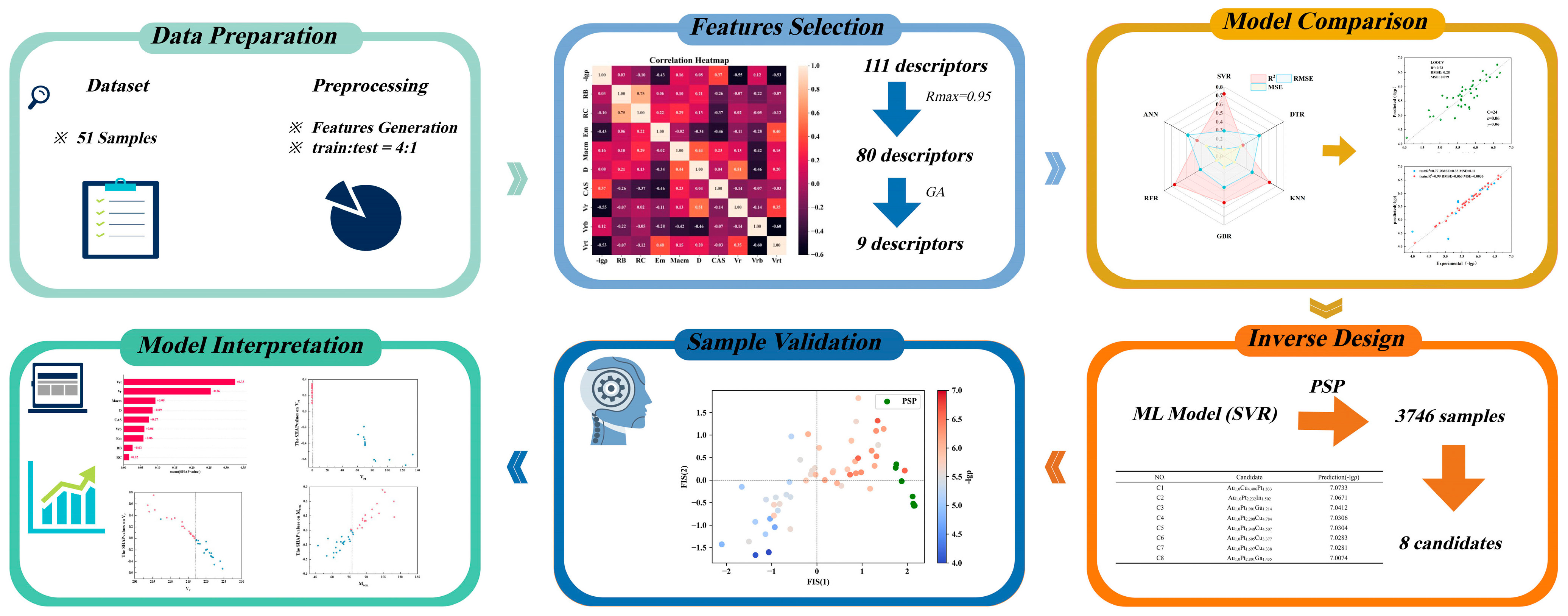
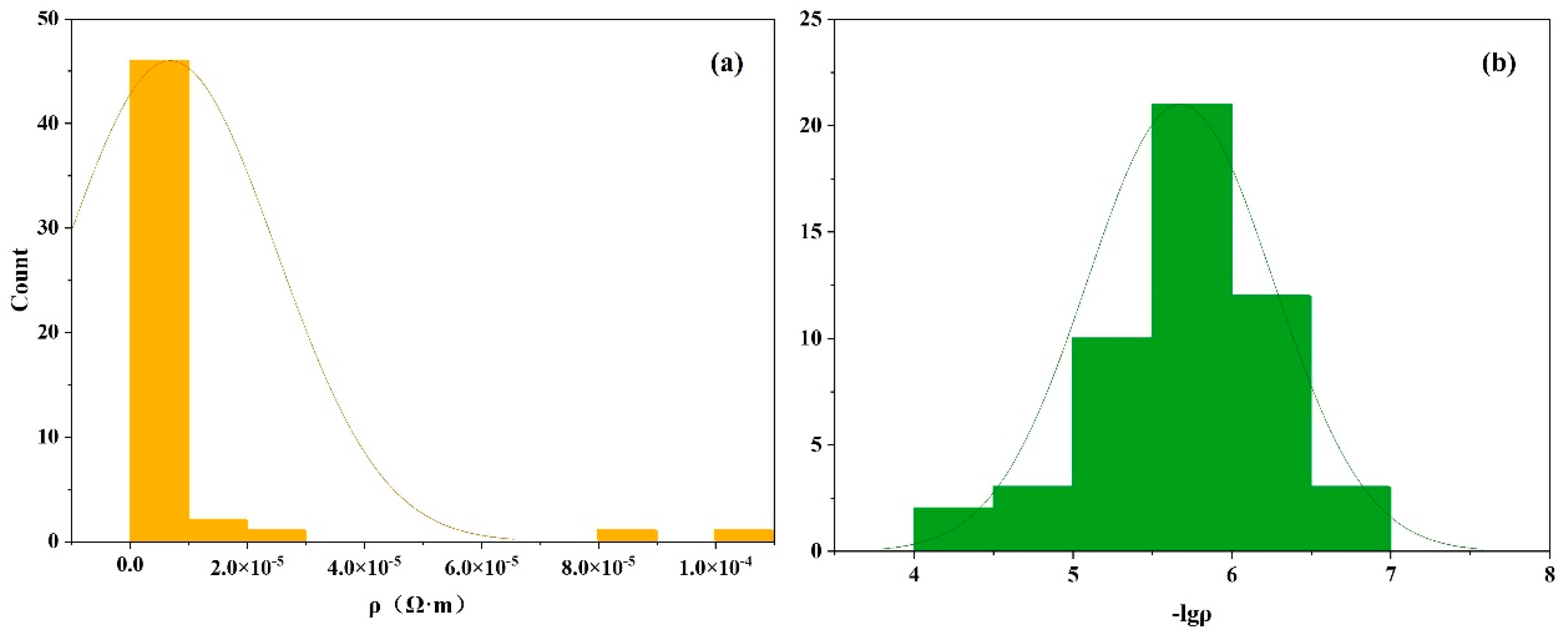

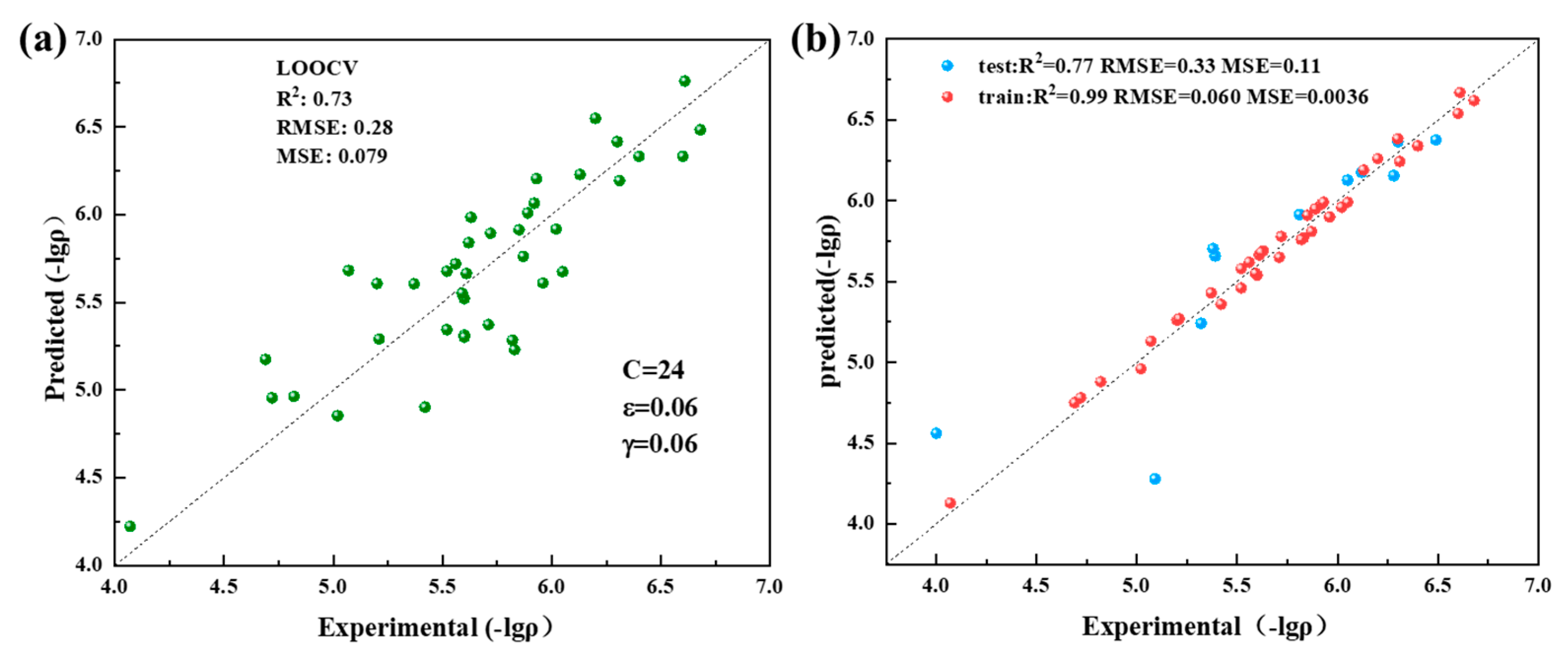
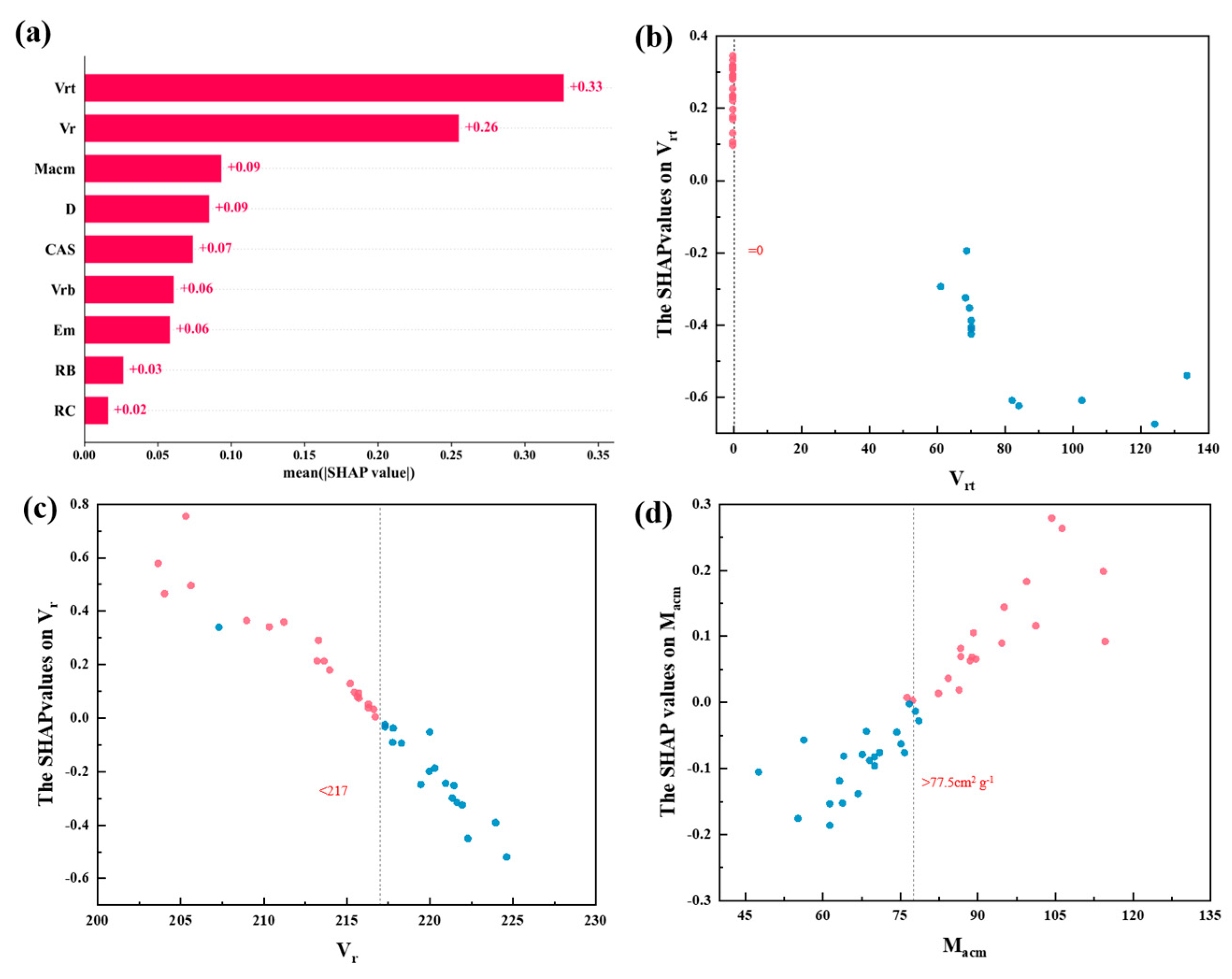
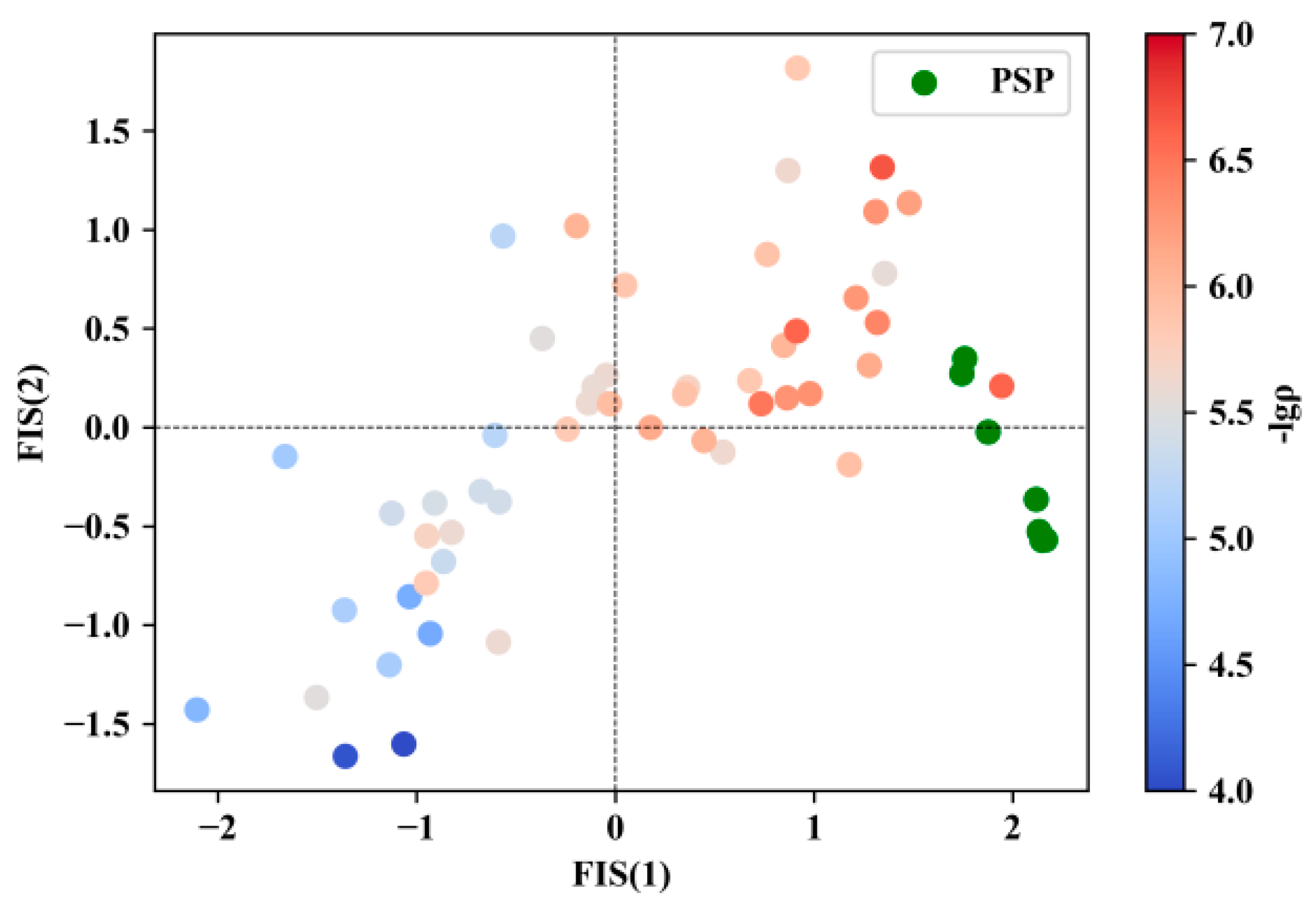

| Features | Description |
|---|---|
| RB | Proportion of element B |
| RC | Proportion of element C |
| Em | Enthalpy melting (kJ mol−1) |
| Macm | Mass attenuation coefficient for MoKalpha (cm2 g−1) |
| D | Distance valence electron (Schubert) (Å) |
| CAS | CAS number |
| Vr | van der Waals Radius [39,40,41] |
| Vrb | |
| Vrt |
| LOOCV | TEST | |||||
|---|---|---|---|---|---|---|
| R2 | RMSE | R | R2 | RMSE | R | |
| average | 0.68 | 0.31 | 0.84 | 0.69 | 0.34 | 0.87 |
| σ | 0.052 | 0.034 | 0.027 | 0.052 | 0.049 | 0.033 |
| NO. | Candidate | Prediction (−lgρ) |
|---|---|---|
| C1 | Au1.000Cu4.406Pt1.833 | 7.0733 |
| C2 | Au1.000Pt2.232In1.502 | 7.0671 |
| C3 | Au1.000Pt1.901Ga1.214 | 7.0412 |
| C4 | Au1.000Pt2.208Cu4.784 | 7.0306 |
| C5 | Au1.000Pt1.948Cu4.507 | 7.0304 |
| C6 | Au1.000Pt1.605Cu3.377 | 7.0283 |
| C7 | Au1.000Pt1.697Cu4.338 | 7.0281 |
| C8 | Au1.000Pt2.801Ga1.435 | 7.0074 |
Disclaimer/Publisher’s Note: The statements, opinions and data contained in all publications are solely those of the individual author(s) and contributor(s) and not of MDPI and/or the editor(s). MDPI and/or the editor(s) disclaim responsibility for any injury to people or property resulting from any ideas, methods, instructions or products referred to in the content. |
© 2024 by the authors. Licensee MDPI, Basel, Switzerland. This article is an open access article distributed under the terms and conditions of the Creative Commons Attribution (CC BY) license (https://creativecommons.org/licenses/by/4.0/).
Share and Cite
Che, H.; Lu, T.; Cai, S.; Li, M.; Lu, W. Inverse Design of Low-Resistivity Ternary Gold Alloys via Interpretable Machine Learning and Proactive Search Progress. Materials 2024, 17, 3614. https://doi.org/10.3390/ma17143614
Che H, Lu T, Cai S, Li M, Lu W. Inverse Design of Low-Resistivity Ternary Gold Alloys via Interpretable Machine Learning and Proactive Search Progress. Materials. 2024; 17(14):3614. https://doi.org/10.3390/ma17143614
Chicago/Turabian StyleChe, Hang, Tian Lu, Shumin Cai, Minjie Li, and Wencong Lu. 2024. "Inverse Design of Low-Resistivity Ternary Gold Alloys via Interpretable Machine Learning and Proactive Search Progress" Materials 17, no. 14: 3614. https://doi.org/10.3390/ma17143614






